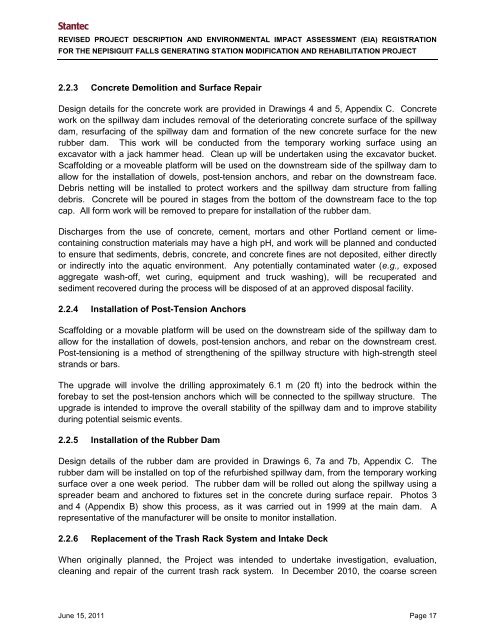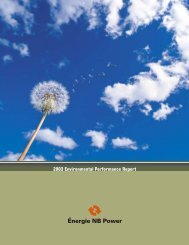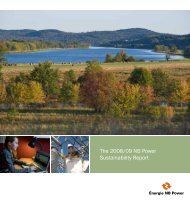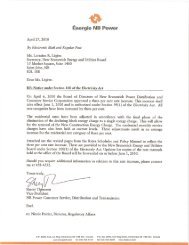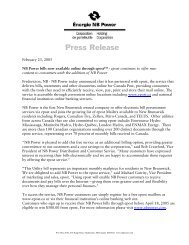Environmental Impact Assessment(EIA) Registration for the ...
Environmental Impact Assessment(EIA) Registration for the ...
Environmental Impact Assessment(EIA) Registration for the ...
You also want an ePaper? Increase the reach of your titles
YUMPU automatically turns print PDFs into web optimized ePapers that Google loves.
REVISED PROJECT DESCRIPTION AND ENVIRONMENTAL IMPACT ASSESSMENT (<strong>EIA</strong>) REGISTRATION<br />
FOR THE NEPISIGUIT FALLS GENERATING STATION MODIFICATION AND REHABILITATION PROJECT<br />
2.2.3 Concrete Demolition and Surface Repair<br />
Design details <strong>for</strong> <strong>the</strong> concrete work are provided in Drawings 4 and 5, Appendix C. Concrete<br />
work on <strong>the</strong> spillway dam includes removal of <strong>the</strong> deteriorating concrete surface of <strong>the</strong> spillway<br />
dam, resurfacing of <strong>the</strong> spillway dam and <strong>for</strong>mation of <strong>the</strong> new concrete surface <strong>for</strong> <strong>the</strong> new<br />
rubber dam. This work will be conducted from <strong>the</strong> temporary working surface using an<br />
excavator with a jack hammer head. Clean up will be undertaken using <strong>the</strong> excavator bucket.<br />
Scaffolding or a moveable plat<strong>for</strong>m will be used on <strong>the</strong> downstream side of <strong>the</strong> spillway dam to<br />
allow <strong>for</strong> <strong>the</strong> installation of dowels, post-tension anchors, and rebar on <strong>the</strong> downstream face.<br />
Debris netting will be installed to protect workers and <strong>the</strong> spillway dam structure from falling<br />
debris. Concrete will be poured in stages from <strong>the</strong> bottom of <strong>the</strong> downstream face to <strong>the</strong> top<br />
cap. All <strong>for</strong>m work will be removed to prepare <strong>for</strong> installation of <strong>the</strong> rubber dam.<br />
Discharges from <strong>the</strong> use of concrete, cement, mortars and o<strong>the</strong>r Portland cement or limecontaining<br />
construction materials may have a high pH, and work will be planned and conducted<br />
to ensure that sediments, debris, concrete, and concrete fines are not deposited, ei<strong>the</strong>r directly<br />
or indirectly into <strong>the</strong> aquatic environment. Any potentially contaminated water (e.g., exposed<br />
aggregate wash-off, wet curing, equipment and truck washing), will be recuperated and<br />
sediment recovered during <strong>the</strong> process will be disposed of at an approved disposal facility.<br />
2.2.4 Installation of Post-Tension Anchors<br />
Scaffolding or a movable plat<strong>for</strong>m will be used on <strong>the</strong> downstream side of <strong>the</strong> spillway dam to<br />
allow <strong>for</strong> <strong>the</strong> installation of dowels, post-tension anchors, and rebar on <strong>the</strong> downstream crest.<br />
Post-tensioning is a method of streng<strong>the</strong>ning of <strong>the</strong> spillway structure with high-strength steel<br />
strands or bars.<br />
The upgrade will involve <strong>the</strong> drilling approximately 6.1 m (20 ft) into <strong>the</strong> bedrock within <strong>the</strong><br />
<strong>for</strong>ebay to set <strong>the</strong> post-tension anchors which will be connected to <strong>the</strong> spillway structure. The<br />
upgrade is intended to improve <strong>the</strong> overall stability of <strong>the</strong> spillway dam and to improve stability<br />
during potential seismic events.<br />
2.2.5 Installation of <strong>the</strong> Rubber Dam<br />
Design details of <strong>the</strong> rubber dam are provided in Drawings 6, 7a and 7b, Appendix C. The<br />
rubber dam will be installed on top of <strong>the</strong> refurbished spillway dam, from <strong>the</strong> temporary working<br />
surface over a one week period. The rubber dam will be rolled out along <strong>the</strong> spillway using a<br />
spreader beam and anchored to fixtures set in <strong>the</strong> concrete during surface repair. Photos 3<br />
and 4 (Appendix B) show this process, as it was carried out in 1999 at <strong>the</strong> main dam. A<br />
representative of <strong>the</strong> manufacturer will be onsite to monitor installation.<br />
2.2.6 Replacement of <strong>the</strong> Trash Rack System and Intake Deck<br />
When originally planned, <strong>the</strong> Project was intended to undertake investigation, evaluation,<br />
cleaning and repair of <strong>the</strong> current trash rack system. In December 2010, <strong>the</strong> coarse screen<br />
June 15, 2011 Page 17


